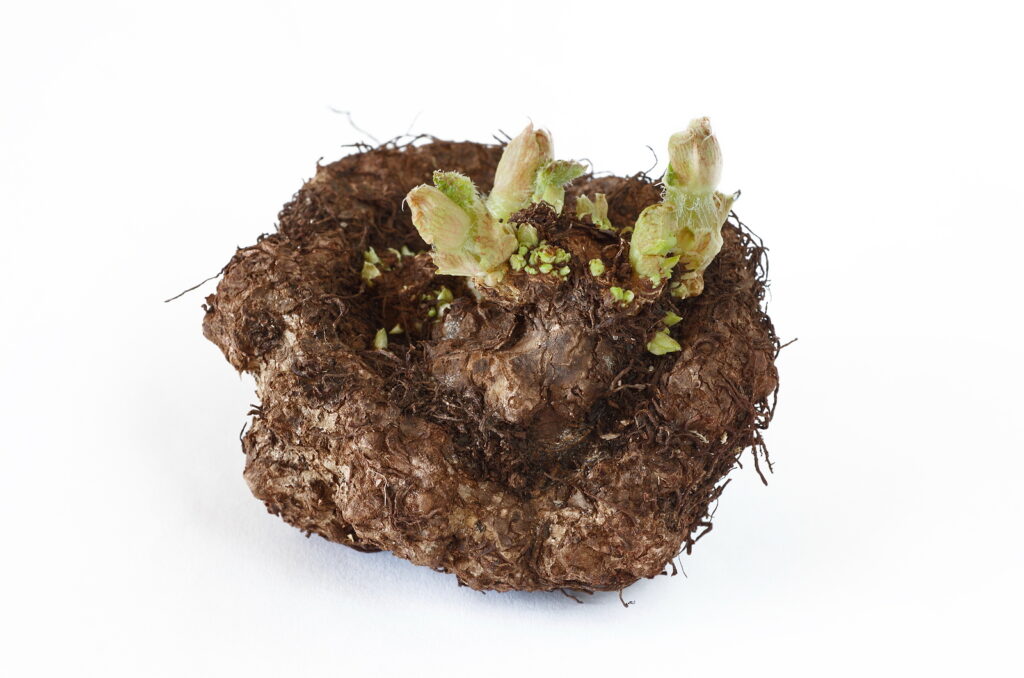Bulbs require care. Though they are seen only part of the year, they are year-round plants. They need feeding, water, and attention just like other plants. Here are tips for bulb care. (Bulb care suggestions include, rhizomes, corms, and tubers.)
Fertilizing bulbs
- Large bulbs need to be fertilized; small bulbs do not need fertilizer.
- Give bulbs a balanced, all-purpose fertilizer when young shoots emerge from the soil. Feed them again after the plant has finished blooming.
- Fertilize bulbs in autumn by applying 1-inch (2.5cm) of aged compost. Alternatively, you can fertilize bulbs by applying an all-purpose fertilizer or a slow-release bulb fertilizer.
Watering bulbs
- Water bulbs when the weather is dry; water bulbs much as you would water perennials and shrubs; keep the soil evenly moist but not wet.
- If your soil is poorly drained, water less. Better yet, amend the soil or move the bulbs to soil that does not stay wet. It is best to plant bulbs in moisture-retentive but well-drained soil; that is humus-rich loamy soil.
Spring-blooming bulb care
- Spring-blooming bulbs include tulips, daffodils, narcissus, and crocus.
- Fertilize spring-blooming bulbs lightly in the fall with a general-purpose, slow-release granular fertilizer or 1-inch of compost spread around and over the top of bulbs.
- Do not feed spring-blooming bulbs in spring during bloom time; too much nitrogen will encourage fungal problems.
- As spring-blooming bulbs finish blooming, allow the foliage to die back and brown; do not cut away foliage that is turning from green to yellow to brown—that foliage is using sunlight to gather nutrients to help the bulb store energy for blooms next year. Allow the foliage to fully brown and wither before cutting it away.
- Mulch around bulbs after they bloom and into summer; mulch will slow soil moisture evaporation and keep the bulbs cool.
- Keep the soil evenly moist; avoid letting the soil and bulbs dry out. Planting annuals above spring-blooming bulbs is one way to keep them moist as the annuals above are watered.
- Label or mark the location of bulbs so that they are not disturbed later in the season; you can also keep a garden map of bulb locations.

Summer-blooming bulbs
- Summer-blooming bulbs include gladiolus, cannas, and daylilies.
- Feed summer-blooming bulbs with an all-purpose fertilizer when foliage appears in spring; feed them once a month while they are in bloom.
- Summer-blooming bulbs that lose their foliage before they bloom such a naked ladies and autumn-blooming crocus need fertilizer while the leaves are green; do not feed these bulbs after they drop their foliage.
Digging and storing summer-blooming bulbs
- In cold-winter regions, tender summer-blooming bulbs, corms, and tubers must be dug up and stored indoors through the winter to be replanted in spring if you want them to rebloom the following summer. The alternative is to plant new summer-blooming bulbs each spring. Summer-blooming bulbs are not winter-hardy.
- Dig up summer-blooming bulbs after the foliage is damaged by the first autumn frost. Lift the bulbs before the foliage completely dies back.
- Dig bulbs with a garden fork being careful not to damage the bulbs. Brush away soil and let them dry for a few days sitting on newspaper in a shady and dry spot. Store them in a paper bag, cardboard box, or wooden crate in a dry place indoors. You can also store them in damp sawdust or sphagnum peat moss. Do not store them in plastic which can promote the growth of mold.
- Store tuberous begonias, dahlia, cannas, and gladioli where night temperatures are 35 to 55°F (2 to 13°C). Cool locations include unheated garages, attics, basements, or crawlspaces.
- Store tuberoses and caladiums where night temperatures are 60 to 75°F (16 to 24°C). Warm places to store these bulbs include closets, and heated basements or attics.
- Check stored bulbs at least once a month to be sure they do not rot, get soft, or shrivel; this can happen if temperatures are too warm or too cool.

Dividing bulbs—bulb propagation
Bulbs should be divided during their dormant period.
- Bulbs are underground stems bases containing an embryonic plant. They reproduce by means of underground offsets called bulblets. Bulblets form on the outside perimeter of the bulb. Bulblets can be removed and planted and they will grow into a full-size bulb. Hyacinth, tulips, narcissus, and lilies are typical bulbs.
- Rhizomes are thickened stems that grow partially or entirely underground. Rhizomes form from older rhizomes as they die. New rhizomes can be cut from the old root and replaced. Clumps of rhizomes can be divided like clumps of perennials. Irises, tuberose, and cannas are typical rhizomes.
- Tuberous roots are true roots that grow from the base of old stems rather than from the roots of the plant. To divide, cut the root cluster apart so each division contains both roots and part of the stem base with one or more growth buds. Tuberous roots include alstroemeria, clivia, dahlia, Hemerocallis, and Persian ranunculus.
- Corms are swollen underground stem bases. Corms form new corms on top of old ones each summer. The old corm shrivels. The new corn is pulled down by its roots to replace the old corm. Gladiolus, freesia, and crocus are typical corms.
- Tubers are swollen underground stem bases. A large tuber can be cut into pieces and replanted to form new tubers; each piece must have a growing point. Be sure that each new division has an eye or two. Let the cut surfaces dry and form a callus before replanting. Dahlia is a typical tuber.
Also of interest:















